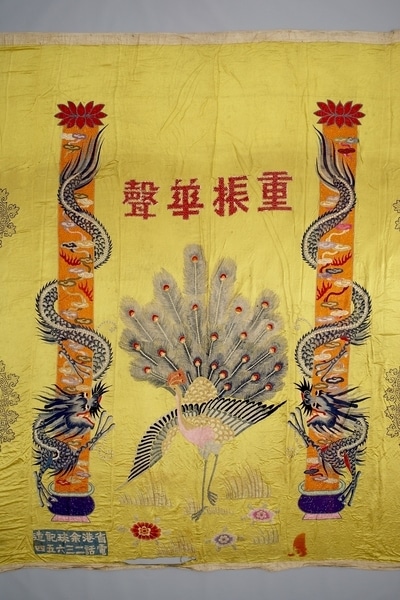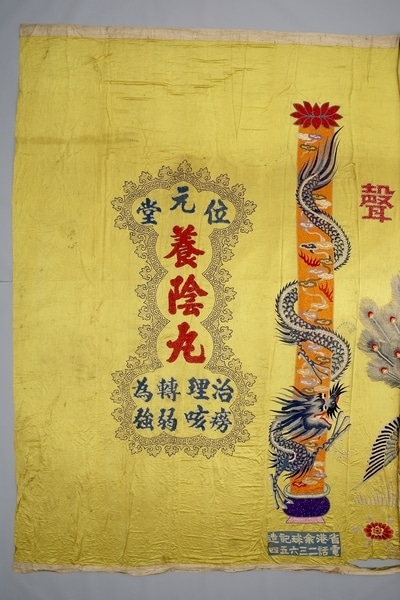Cantonese Opera Stage Curtain Item Number: Edz1823 from the MOA: University of British Columbia



Description
A very large yellow silk curtain that has an embroidered design with a sequin design at either side. The embroidered design is consisting of a central bird that has a pink body, red plumage on its head, and blue peacock-like feathers with yellow, orange, and red centres. There are brown grasses with an orange-red flower below the bird and a purple flower to the right with a pink flower at the end. A horizontal line of four red writing characters (characters) is above the bird. At each side of the bird, there is a blue four-clawed dragon on vertical orange band that has cloud shapes in shades of green, blue, pink, and red. Below each dragon, there is a pot that has a mint green rim, a dark purple body, and a pink bottom. Above each dragon, there is a red lotus bordered by blue. The right sequin design has a horizontal line of four blue characters in the upper section, a vertical line of three red characters in the middle section, and two horizontal lines of four blue characters with a red dot below in the lower section. The left sequin design has a horizontal line of three blue characters in the upper section, a vertical line of three red characters in the middle section, and two horizontal lines of four blue characters in the lower section. Both sequin designs are bordered by a black sequin band that has a geometric design within, and multiple five-lobed protrusions around it. The shape of each border is consisting of three lobes around the top, and bottom with three lobes around the middle. Below the left sequin design, there is a light blue band with two horizontal lines of six (upper), and seven (lower) off-white characters.
Narrative
Stage curtain used by the Jin Wah Sing troupe of Vancouver. Jin Wah Sing’s name is emblazoned across the top.
Iconographic Meaning
Silk is yellow, the colour of abundance and imperial ruler ship. Reminiscent of a divine altar, the symmetrical composition features a large peacock in the centre. The peacock is known for renewing its feathers every year and thus serves as a talisman of regeneration and eternal youth, like the phoenix. The peacock also appears as the mystical steed for Xiwangmu (Queen Mother of the West), the cosmic weaver and Daoist goddess of immortality. On either side of the peacock are two embroidered dragon pillars with cloud patterns, a reference to the emperor’s role as an intermediary between heaven and earth. The two dragons are positioned as guards and face inward towards the peacock in a protective posture to ward off evil spirits. The pairing of the peacock (feminine) and dragons (masculine) conveys a harmonious balance, at the same time fulfilling the opera’s ritual function of harnessing the auspicious while repelling the inauspicious. There are advertisements for traditional Chinese medicine companies as well. This combination of images and texts creates a direct connection and alignment between the traditional medicines and the magical efficacy of the opera and their healing powers.
Item History
- Made in China during 1930
- Owned by Jin Wah Sing Musical Association before September 24, 1991
- Received from Jin Wah Sing Musical Association (Donor) on September 24, 1991
What
- Name
- Cantonese Opera Stage Curtain
- Identification Number
- Edz1823
- Type of Item
- curtain
- Material
- silk fibre, glass and cotton fibre
- Overall
- height 4.5 m, width 7.0 m
Who
- Culture
- Chinese
- Previous Owner
- Jin Wah Sing Musical Association
- Received from
- Jin Wah Sing Musical Association (Donor)
Where
- Holding Institution
- MOA: University of British Columbia
- Made in
- China
When
- Creation Date
- during 1930
- Ownership Date
- before September 24, 1991
- Acquisition Date
- on September 24, 1991
Other
- Item Classes
- textiles
- Condition
- poor
- Accession Number
- 1488/0193